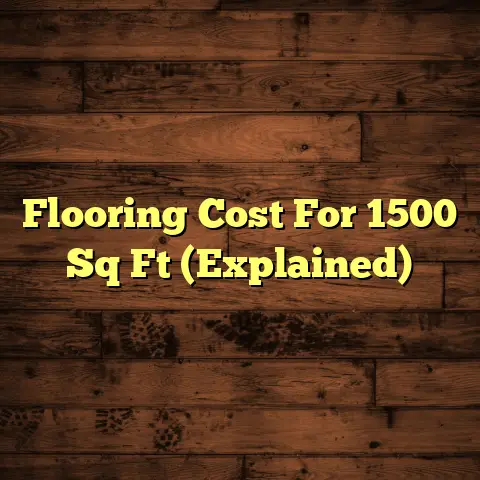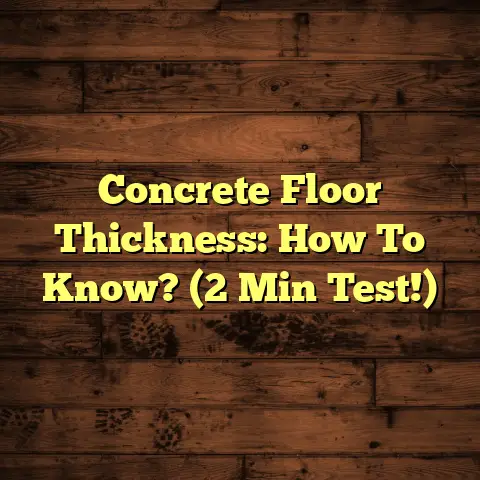Laminate Flooring Costs? (6 Factors Impacting)
Today, I want to chat about laminate flooring. It’s a fantastic option that blends affordability with style.
One of the biggest draws of laminate is the long-term savings. It’s durable, easy to maintain, and can mimic the look of pricier materials like hardwood or tile.
But how do you navigate the costs? What impacts the final price you pay?
Let’s dive into the six key factors that influence laminate flooring costs, so you can make a smart, informed decision.
Section 1: Understanding Laminate Flooring
So, what exactly is laminate flooring? Simply put, it’s a multi-layered synthetic flooring product fused together through a lamination process.
Think of it like a super-durable sandwich!
It typically consists of four layers:
-
Wear Layer: This is the top, transparent layer that protects against scratches, stains, and fading.
-
Design Layer: This is a high-resolution photographic image that gives the laminate its realistic wood, stone, or tile appearance.
-
Core Layer: This is the main body of the plank, usually made of high-density fiberboard (HDF) or medium-density fiberboard (MDF). This layer provides stability and impact resistance.
-
Backing Layer: This is the bottom layer that provides moisture resistance and helps prevent warping.
Laminate is wildly popular in both homes and businesses, and I know why. It’s affordable, looks great, and is versatile enough to fit almost any design aesthetic.
Plus, it’s relatively easy to install and maintain, making it a winner in my book.
Section 2: The Cost Breakdown of Laminate Flooring
Okay, let’s talk numbers. What can you expect to pay for laminate flooring?
The average cost per square foot generally ranges from $1 to $5 for the materials alone.
However, that’s just a starting point.
Keep in mind that higher-quality laminates with enhanced features can easily push the price above that range.
Here’s a general breakdown of what that price typically includes:
- Material Costs: The cost of the laminate planks themselves.
- Installation Fees: If you’re hiring a professional, this covers their labor.
- Underlayment: A crucial layer that goes beneath the laminate to provide cushioning, sound insulation, and moisture protection.
- Additional Materials: Things like transition strips, baseboards, and adhesives.
Now, location matters. Prices can vary depending on where you live. For instance, I’ve noticed that in major metropolitan areas, both materials and labor tend to be more expensive.
Market trends also play a role. If there’s a high demand for a particular style or brand, you might see prices increase.
Section 3: Factor 1 – Quality of Materials
This is a big one! The quality of the laminate directly impacts its price, durability, and overall appearance.
Let’s break it down:
-
Lower-End Laminate: Typically thinner, with a less realistic design layer and a lower AC (Abrasion Class) rating. Expect to pay around $1 to $2 per square foot. It’s okay for low-traffic areas, but don’t expect it to last forever.
-
Mid-Range Laminate: A good balance of quality and price. Offers better durability, a more realistic appearance, and a decent warranty. Expect to pay around $2 to $4 per square foot. This is a solid choice for most homes.
-
High-End Laminate: The cream of the crop. Features a thick wear layer, incredibly realistic designs, excellent water resistance, and a long warranty. Expect to pay $4 or more per square foot. Ideal for high-traffic areas, homes with pets, or anyone who wants the best.
The Abrasion Class (AC) rating is key. It measures the laminate’s resistance to abrasion, impact, and stains.
AC ratings range from 1 to 5, with 5 being the most durable.
Higher AC ratings mean the floor can withstand more wear and tear, which is crucial for busy households.
Think about the warranty too! A longer warranty usually indicates a higher-quality product.
Section 4: Factor 2 – Installation Costs
Here’s where you have a choice: DIY or professional installation?
DIY can save you money upfront, but it requires time, patience, and the right tools.
If you’re not experienced with flooring installation, it can be tricky.
Professional installation costs vary depending on several factors, including:
- Floor Preparation: Is your subfloor level and clean? If not, it needs to be prepped, which adds to the cost.
- Subfloor Conditions: If your subfloor is damaged or uneven, it may need to be repaired or replaced.
- Complexity of the Installation: Intricate patterns or tricky layouts will increase labor costs.
On average, labor costs for professional laminate installation range from $2 to $5 per square foot.
But remember, that’s just an average.
Removing old flooring can add another $1 to $3 per square foot to the total cost.
If you’re not comfortable with DIY, I always recommend hiring a professional. A bad installation can lead to problems down the road, costing you more money in the long run.
Section 5: Factor 3 – Underlayment Choices
Don’t underestimate the importance of underlayment! It’s the unsung hero of your laminate floor.
Underlayment provides several benefits:
- Cushioning: Makes the floor more comfortable to walk on.
- Sound Insulation: Reduces noise transmission between floors.
- Moisture Resistance: Protects the laminate from moisture damage.
- Leveling: Helps to even out minor imperfections in the subfloor.
There are several types of underlayment available, each with its own price point:
-
Foam Underlayment: The most common and affordable option, typically costing around $0.20 to $0.50 per square foot. Good for basic cushioning and sound insulation.
-
Cork Underlayment: A natural and eco-friendly option, offering excellent sound insulation and moisture resistance. Costs around $0.50 to $1.50 per square foot.
-
Rubber Underlayment: Provides superior sound insulation and shock absorption. Ideal for apartments or homes with kids. Costs around $1 to $3 per square foot.
-
Attached Underlayment: Some laminate planks come with underlayment already attached. This can save you time and money, but the quality of the attached underlayment may not be as good as a separate layer.
Choosing the right underlayment depends on your specific needs and budget. If you live in an apartment, soundproofing is crucial. If you have a damp basement, moisture resistance is key.
Section 6: Factor 4 – Brand and Manufacturer
Just like with any product, brand reputation and manufacturer quality can significantly impact the price of laminate flooring.
Established brands often charge a premium for their products due to their reputation for quality, durability, and customer service.
Some popular brands in the laminate flooring market include:
-
Pergo: Known for its durable and water-resistant laminates. Prices range from $2.50 to $5 per square foot. https://www.pergo.com/
-
Shaw Floors: Offers a wide variety of styles and price points. Prices range from $2 to $4.50 per square foot. https://shawfloors.com/
-
Armstrong Flooring: A trusted name in the flooring industry, with a focus on quality and innovation. Prices range from $2 to $5 per square foot. https://www.armstrongflooring.com/
-
Mohawk Flooring: Known for its stylish designs and durable construction. Prices range from $2 to $4 per square foot. https://www.mohawkflooring.com/
While well-known brands often come with a higher price tag, they also tend to offer better warranties and customer support.
However, don’t discount smaller or lesser-known brands. You might find a hidden gem that offers great quality at a lower price.
Always read reviews and do your research before making a decision.
Section 7: Factor 5 – Style and Design
Believe it or not, the style and design of your laminate flooring can also influence its cost.
Certain colors, textures, and plank sizes may be more expensive due to higher demand or more complex manufacturing processes.
For example, wider planks often cost more than narrower planks.
Similarly, laminates with intricate textures or realistic wood grain patterns can be pricier.
Here are some popular design choices and their associated costs:
-
Wood-Look Laminate: The most popular choice, mimicking the look of hardwood floors. Prices vary depending on the species and grain pattern.
-
Stone-Look Laminate: Replicates the look of tile or stone, often used in kitchens and bathrooms. Can be slightly more expensive than wood-look laminate.
-
Hand-Scraped Laminate: Features a textured surface that mimics the look of hand-scraped hardwood. Adds a touch of rustic charm but can be more expensive.
-
Waterproof Laminate: Designed to withstand moisture and spills, ideal for bathrooms, kitchens, and basements. Generally more expensive than standard laminate.
Keep an eye on trends! Certain styles may be in high demand, driving up the price.
Section 8: Factor 6 – Location and Market Conditions
Finally, let’s talk about how geographical factors and local market conditions can affect laminate flooring costs.
As I mentioned earlier, prices can vary depending on your location. Areas with higher labor costs or higher demand for flooring may have higher prices.
Shipping costs can also play a role, especially if you’re ordering from a supplier that’s far away.
Local market conditions can also fluctuate depending on the economy, seasonal demand, and competition among retailers.
Here are some tips for gauging local market conditions and finding the best deals:
- Shop Around: Get quotes from multiple flooring stores and contractors.
- Compare Prices Online: Check online retailers for competitive pricing.
- Look for Sales and Promotions: Many stores offer discounts during certain times of the year.
- Consider Buying in Bulk: If you’re flooring a large area, you might be able to negotiate a better price.
- Be Flexible with Your Style: If you’re open to different styles and colors, you might find a better deal.
Conclusion
So, there you have it – the six key factors that impact laminate flooring costs!
Understanding these factors can help you make an informed decision that aligns with your budget and long-term savings goals.
Remember, while laminate flooring is a cost-effective option, it’s important to do your research, compare prices, and choose a product that meets your specific needs and preferences.
By considering these factors, you can ensure that you get the best value for your money and enjoy beautiful, durable laminate floors for years to come.
Happy flooring!





